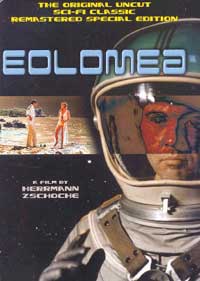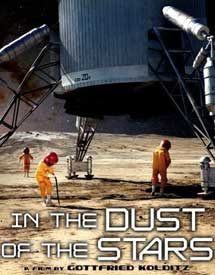Apart from the nice model for the primary spaceship, this East German science fiction offers little to praise. In the Dust of the Stars (Im staub der sterne, 1976) moves slowly & is dull. The interior sets are all cheap looking so that when an establishing shot of a nice-looking model cuts to a crappy-looking interior, there's no sense that the exterior & interior are the same place.
A ship lands on an unknown world from whence they have received a request for emergency aid. The cosmonauts are greeted by a woman in a van which transports them across a stark environment to some minimalist sets where they're entertained by go-go, disco, & burlesque dancers, & get drunk on big cans of Binaca peppermint schnaps breath spray.
The request for emergency aid they're informed was a test & no one ever imagined some other planet would hear it & respond. With the assistance of a little brainwashing technique the would-be rescuers believe this twaddle & are ready to take off for their home world telling each other how the natives are very nice but a little crazy.
One of the cosmonauts had remained on the ship so didn't get brainwashed & is quite certain the rest of the crew is acting funny. He sets out to investigate on his own & discovers that the people they met are actually invaders & the planet's true citizens are enslaved in the mines. More troubles unfold until finally the laborers are liberated.
 I'd expected to enjoy In the Dust of the Stars at least for its historical interest as international science fiction cinema. But it was merely awful. The film came in a set of three plus extras, among which only The Silent Star (1960) was not wearingly dull. I doubted the third film could be as boring was In the Dust of Stars, but as wonder of wonders, Eolomea (1972) defines boring. I'd expected to enjoy In the Dust of the Stars at least for its historical interest as international science fiction cinema. But it was merely awful. The film came in a set of three plus extras, among which only The Silent Star (1960) was not wearingly dull. I doubted the third film could be as boring was In the Dust of Stars, but as wonder of wonders, Eolomea (1972) defines boring.
If you blink a couple of times you'll miss what little action exists. A few scenes of space & models of ships landing, & a few shots of alien landscapes, are semi-interesting momentary visuals. Most of the time we just watch characters talk, jabber, & speculate.
The talked-about but not shown "plot" regards the disappearance in swift succession of eight ships attempting to reach space station Margot. What is happening to the ships becomes, improbably, an excuse for an ongoing Socialist Utopian Dialogue around which any science fiction content is beside the point.
There are a few moments enlivened by conversations with the ugliest "cute robot" in all sci-fi. I was also amused by passing mention of a colony of Venus called Bradburyville. After all points of mystery are talked to death & its time to end the film, a quasi-religious quest for the planet Eolomea is tacked on, repleat with phony "mystical" moments & cut-rate psychedelic visuals badly copies out of 2001: Space Odyssey.
It's not that philosophical science fiction is inherently a bad idea, or that communists inevitably spoil the finer possibilities with too great an agenda. One need only see the original Solaris (1972) to realize mystical science fiction from a communist country can be mesermizing. But Eolomea is a bloody hemorrhoid.
copyright © by Paghat the Ratgirl
|

